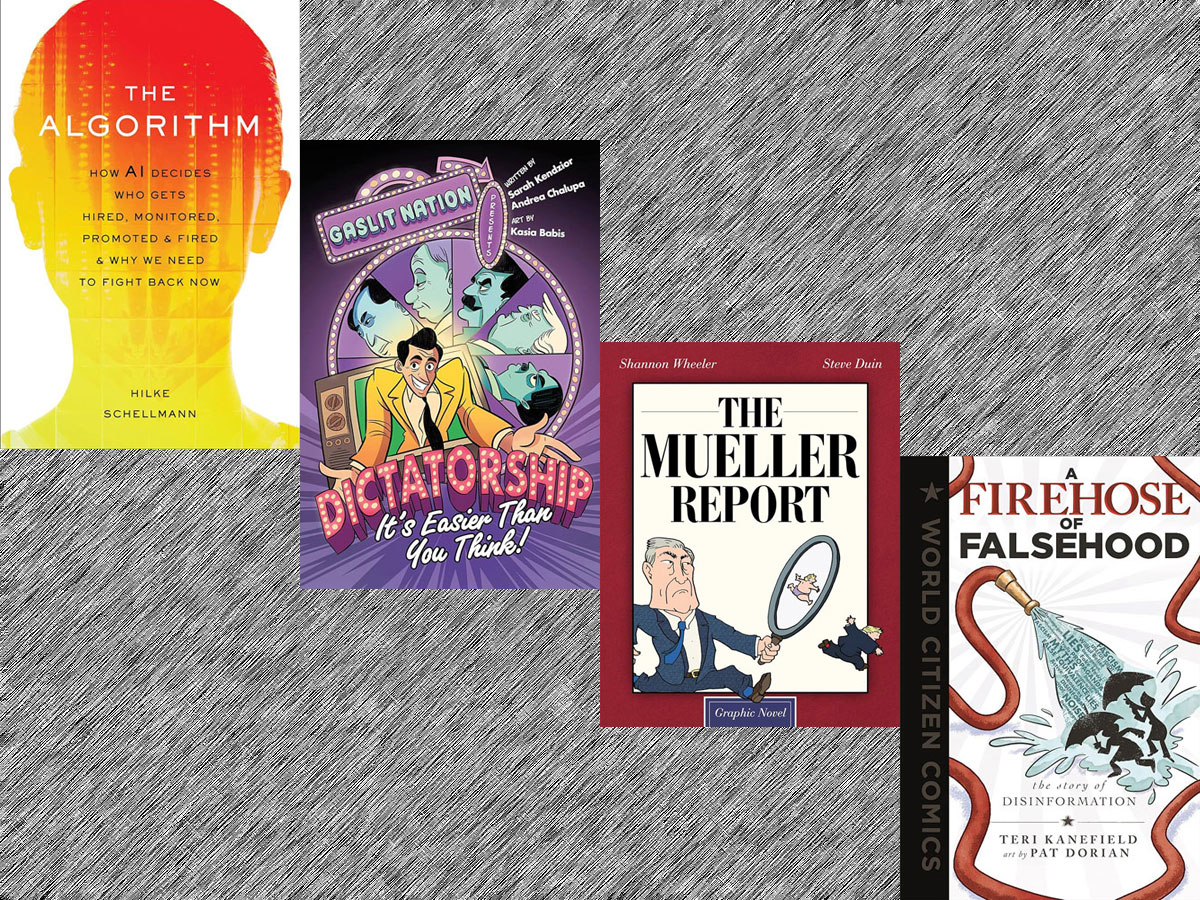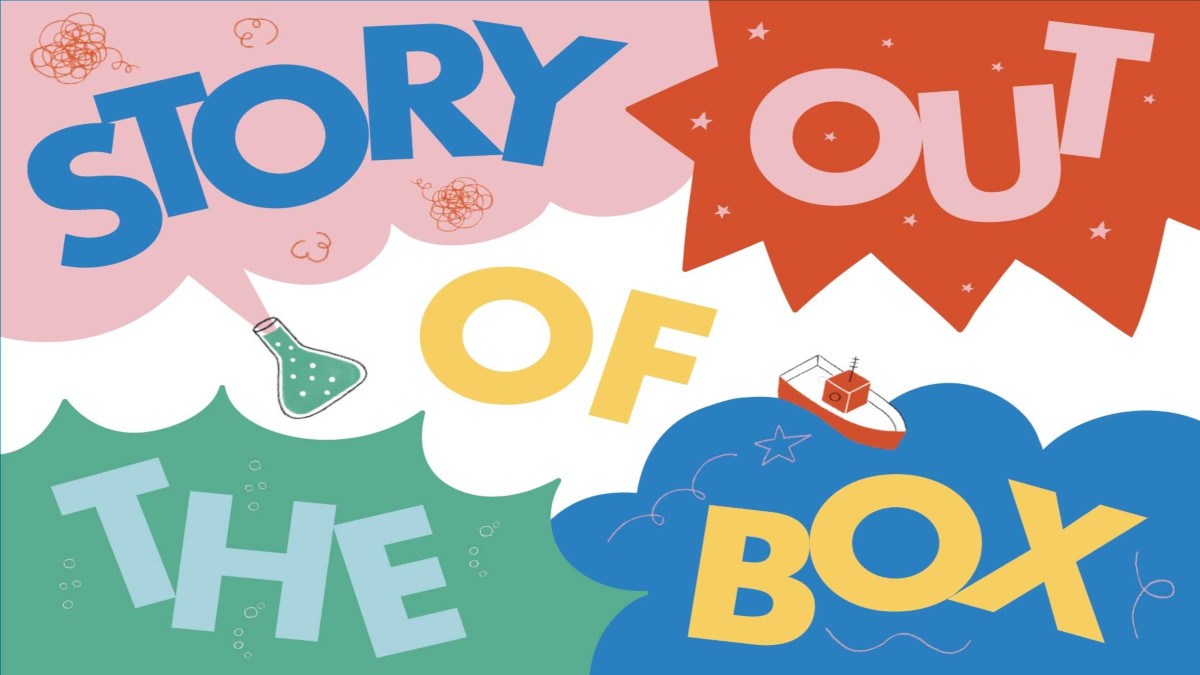Sometimes you read to escape the world or as comfort food—something that makes you feel warm and safe and happy. And sometimes you read things that are uncomfortable but you feel like they’re useful or important to learn. Today’s stack is the second type, so brace yourself for some discomfort food.
The Algorithm by Hilke Schellmann
The full subtitle for this book is “How AI Decides Who Gets Hired, Monitored, Promoted & Fired & Why We Need to Fight Back Now,” so that gives you a pretty good idea of what this book is about. Schellmann is a writer for the Wall Street Journal and the Guardian, and in this book she digs into ways that software and algorithms are playing an increasingly prominent role in HR-related functions. One-way video interviews where you record yourself answering questions with nobody on the other end except a program that’s attempting to analyze your facial expressions or tone of voice. Videogames you play as part of the application process that supposedly measure various skills. Software that scans your social media profiles and builds a personality profile. Those are just some of the ways that algorithms are used in the hiring process—there’s even more about how firing decisions are often made without any real human input, or how more and more companies are using some sort of surveillance on their employees.
Schellmann tells the story through a lot of different angles: she interviews people who have been exposed to various technology in the application process, developers of the various software products, as well as people who have expertise in fields like psychology or AI or statistics. For the most part, things look pretty bleak: it feels like the vendors often exaggerate (or simply make up) what their products are actually capable of doing, and even though they claim that their products are just tools and aren’t responsible for making the actual hiring/firing decisions, it turns out that in private that’s really the way they’re selling their services to companies. After all, if you still need a human to spend the time to double-check the work, that’s not really saving time and money, right? It’s so much easier to just trust that the software is unbiased and accurate.
There is not nearly enough third-party testing and verification involved, Schellmann says, and it turns out that replacing human decision-makers with software doesn’t always eliminate the biases and prejudices—sometimes it reinforces them, and sometimes it introduces new injustices. This isn’t a new concept, either: Cathy O’Neil covered this extensively in her book Weapons of Math Destruction. What this particular book brings to light is how software is used specifically in the realm of jobs, and what surprised me the most is how long it’s already been happening. As somebody who has been out of the workforce for a long time (I’m a stay-at-home dad), I haven’t experienced the job market recently or used any of the various services that I hear advertised like Monster.com or Indeed. It feels like companies are fighting an arms race—they are overwhelmed with resumes and applications, and so they’ve turned to whatever will help them weed out the numbers, even if they admit that qualified candidates are getting rejected.
Even though I found the subject matter engaging, there were some strange takes and missteps, too. The subtitle says “AI” but Schellmann uses “AI,” “machine learning,” and “algorithms” interchangeably even in cases where it’s not actually AI (not even the current flavor of “AI” that many have argued isn’t actually intelligent). While evaluating some software that builds a personality profile based on your social media, Schellmann discusses the way that the same program reported very different personalities based on her LinkedIn account compared to Twitter, but never suggests that people post very different types of things on the two sites, nor does she question how this program would evaluate somebody who doesn’t use social media. And there was at least one instance where an entire paragraph (explaining the “four-fifths rule”) was repeated verbatim later in the book, so it sometimes felt like a series of collected articles rather than one cohesive book.
That said, the book is eye-opening and, I’ll admit, pretty infuriating at times. Reading about the experiences of people who haven’t been able to find jobs, or who got fired by automated systems, or who are constantly monitored at work just feels like a nightmare, and fighting it can feel futile. Schellmann has some proposals for how we rein things in, but it is costly and would require companies to buy into it, which is frustrating when so many seem ready to just take any marketing at face value. There are too many snake oil salesmen, and not enough people exercising a healthy skepticism about their claims. If you’ve wondered about the ways that tech has wormed its way into HR, The Algorithm has plenty of examples.
Dictatorship: It’s Easier Than You Think! written by Sarah Kendzior and Andrea Chalupa, art by Kasia Babis
This comic book from the hosts of the Gaslit Nation podcast outlines the tactics that dictators use to seize power and maintain control. It has a tongue-in-cheek presentation: a slick motivational speaker teaches various techniques as if he’s giving a how-to seminar, with details about how all of his favorite dictators have put them into practice. The illustrations are made to match: when discussing Stalin and Hitler’s pact, the scene shows the two dictators sharing a coy look across a cafe with cupids fluttering in the background.
The book has a pretty broad scope and jumps around both geographically and temporally, and does not shy away from current hot button issues, either. Putin makes several appearances, as does the whole Kim family of North Korea, and Trump also appears as a wanna-be, using pages from the same playbook. The book also looks at what happens when things fall apart, with “suggestions” about how to stretch out your reign and postpone your downfall as long as possible. The book shows how easy it can be for a dictator to rise to power, even in places that think they’re immune; the defense against this is primarily knowledge and the ability to see the signs that it’s happening, but it doesn’t always make for pleasant reading. The stories of what dictators have done throughout history, all grouped together in a single book, is something that may benefit from some lighter fare between chapters.
The Mueller Report: Graphic Novel by Shannon Wheeler and Steve Duin
Remember the Mueller Report? Special Counsel Robert Mueller led an investigation into whether Donald Trump colluded with Russia to interfere with the election in 2016, and when a redacted version was finally released, it seemed like both sides were able to pick their favorite statements from it to report, either claiming that the report exonerated Trump or that it showed proof of a crime, though Mueller threaded the needle there and passed the buck to Congress to decide about impeachment.
This is a comic book adaptation of the report, with a cartoon version of Mueller speaking to the reader while Wheeler (of Too Much Coffee Man fame) gets a lot of mileage out of his diminutive portrayal of Trump as seen in some of his single-panel cartoons. Even though this is old news now—this book was published in 2020—it’s still somewhat shocking to read about it all again, and see all of the things that Trump and his associates did. Many, of course, did end up being charged with crimes and were sentenced. With Trump’s current trial in the news now, it feels a bit like a repeat of this… or an extension: are we still chasing this?
A Firehose of Falsehood: The Story of Disinformation written by Teri Kanefield, illustrated by Pat Dorian
This title is from First Second’s World Citizen Comics line, and it is focused on disinformation: lies that are presented as the truth. While it is related to propaganda (biased or misleading information to promote a particular cause) and misinformation (information that has errors or mistakes), disinformation is a deliberate use of false information. Some of this book overlapped with Dictatorship (see above), since disinformation is one of the tactics that has been used by dictators throughout history. This book does a deep dive into how disinformation works—the strong personalities that can get it started, the circumstances that allow it to spread, and even the way that technology has a hand in propagating it. It has a lot of call-out boxes defining terms, and also provides suggestions for how to combat disinformation. One of the big lessons is that it is hard to fight lies by just trying to state the truth: social scientists Christopher Paul and Miriam Matthews compare it to fighting a firehose with a squirt gun. Instead, sometimes the best approach is to give raincoats to the people who are getting hit by the firehose, showing them how to recognize disinformation when they encounter it.
It feels ever more important now for us to learn how to spot both disinformation and misinformation. AI-generated images are getting more and more realistic, and many people share them on social media without realizing they aren’t actual photos. AI-generated text often sounds good but can contain factual errors, and we’re already seeing the way it can outpace human-written text online. We need to be able to recognize fact from fiction before we hit “share.” One section of the book specifically traces the ways that Russian disinformation specialists targeted the 2016 presidential election, targeting both sides of the political spectrum to build distrust and animosity, with examples of one of the groups and the type of things they would post. The tools they have access to are only getting more sophisticated now. I’d recommend A Firehose of Falsehood particularly to those who get a lot of their news and information from social media now, because even though disinformation can be spread in other mediums, social media has become one of the most effective ways to spread it.
My Current Reads
Speaking of uncomfortable truths, one of my latest reads is The Boy from Clearwater, a two-part comic book biography about Tsai Kun-lin that covers a broad swathe of Taiwan’s history, particularly the tumultuous years during the Cultural Revolution when the Kuomintang government moved to the island. It’s a very different perspective than the one I grew up hearing, and I’m learning a lot that I hadn’t heard of before. I’ll share more about this one after I’ve finished Book 2.
I’ve also been doing some lighter reading—mostly comics—so we’ll have another pile of those coming up!
Disclosure: I received copies of the books included in today’s column. Affiliate links to Bookshop.org help support my writing and independent booksellers!








